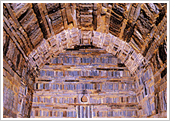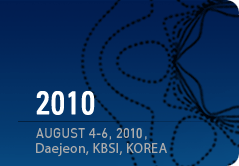 About Buyeo and Gongju About Buyeo and Gongju
Buyeo, Gaeum River flows calmly as a long silk meanderingly spread. The River reaches Buyeo and earned a name, Baekma River. Buyeo is a place of vivid history pleasingly presented by Baekma River. This is the place of the glorious civilization of the Capital of Baekje era. Buyeo is located southwest of the centre of Korea, Chungchungnamdo. Its size is 624§´ and has 80 thousands of population. Buyeo was considered as a convenient place to live even in the prehistoric era. This environmental situation led establishment of Songgukri settlement, which is the biggest settlement of the Orient, and it became the Capital of Baekje. (AD 538 to AD660)

 Tomb of King Muryeongwang Tomb of King Muryeongwang
 |
In the earlier years Ungjin age, Baekje tried to exchange with Chinese Dynasties of Song and Beiwei but the exchange was not smooth since Gogugyo, northen kingdom in the Korean Peninsula, ruled west sea, which was the only path to China from Baekje.
after transferring the capital by diplomacy with China based on restored national power and rearranged national system. Thanks to such efforts, the exchange between Baekje and China was opened again by depriving |
the maritime power of Goguryo in King Muryeongwang period.
The evidence of the exchange was concretely proved by chinaware found in the bases at Geumgang (River) such as Buyeo, Iksan, and Buan as well as Chinese articles found in brick tombs at Songsan-ri and Tomb of King Muryeongwang.
Brick Tomb No.6 and No. 7 (Tomb of King Muryeongwang) are the important key to indicate that the exchange with China was opened again by restoring maritime power in the west sea.
Funeral culture was largely popular in southern China, and it was also spread to Baekje and the coins buried in Tomb of King Muryeongwang are classified into 28 types, which were almost same in the shape, letter, and pattern as those of south China at that time and found at Gongju area in Ungjin age only mainly in old tombs at Songsan-ri and Gyochon-ri such as Tomb of King Muryeongwang, Songsan-ri Tomb No.6, and Gyochon-ri Tomb No.3 |
 Gongsanseong Gongsanseong

Buyeo, Gaeum River flows calmly as a long silk meanderingly spread. The River reaches Buyeo and earned a name, Baekma River. Buyeo is a place of vivid history pleasingly presented by Baekma River. This is the place of the glorious civilization of the Capital of Baekje era. Buyeo is located southwest of the centre of Korea, Chungchungnamdo. Its size is 624§´ and has 80 thousands of population. Buyeo was considered as a convenient place to live even in the prehistoric era. This environmental situation led establishment of Songgukri settlement, which is the biggest settlement of the Orient, and it became the Capital of Baekje. (AD 538 to AD660)
 The Gongju National Museum The Gongju National Museum

Gyeryongsan National Park was designated as the national park in Dec. 31, 1968.
Gyeryongsan mountain stretches throughout Daejeon, Gongju and Nonsan as the best mountain in Chungnam. It is between Charyong range and Noryeong range.
Gyeryongsan mountain was named because its ridgeline is similar to a dragon wearing a crest of a chicken. The geographical feature and scenery of Gyeryongsan mountain is beautiful and in terms of the theory of configuration of the ground, it is the celebrated mountain.
 Gyeryongsan National Park Gyeryongsan National Park

The Gongju National Museum is located in Gongju which was the capital of Ungjin Baekje. The Gongju National Museum is a theme museum that showcases the culture of the Ungjin Baekje Dynasty. It also serves as a space of history and culture by exhibiting every relic excavated from Muryeongwangneung
 Climate Climate
Buyeo and Gongju have a temperate climate, with an annual average temperature of 12.4 ¢ªC. The average temperature is 0.4 ¢ªC in winter and 24.6 ¢ªC in summer, showing 24.2 ¢ªC of difference in temperature. The annual average precipitation is 1388.4mm, most of precipitation concentrated in summer owing to the effect of the north pacific high atmospheric pressure. |
|






